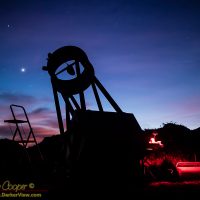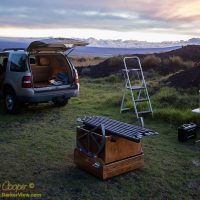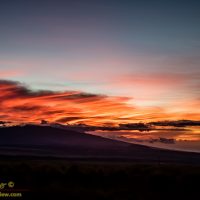A dark night under the stars! It has been too long… Why not?

After all the work restoring the 20″ Obsession it was time to get it out under the stars for a decent observing run. During the many hours of work I had looked forward to simply using this telescope for a bit. While it would eventually be stored at the observatory and used for outreach, it seemed a shame not to spend a night or two under the stars with this instrument. Not like I need a 20″ telescope, my 18″ is just fine, but I loaded it up just the same, leaving Deep Violet in the garage.

My favorite close by site is KaʻOhe, taking only a twenty minute drive from home to reach. At 5,700 feet on the side of Mauna Kea nearby home does not mean second rate. I really like this spot, the view is spectacular with the coastline below and the Mauna Loa and Hualālai volcanoes dominating the horizon. The entire southern horizon is unobstructed, allowing observations of southern objects right down to the horizon.
Better yet, recent rains meant green grass and a spot near the road maintenance gravel pile was hard packed rock, no dust! The area had even been mown recently! I sometimes have a few uncharitable words to describe DLNR, but not this evening.
The site has another advantage… It is directly down wind from the usual direction of the tradewinds. A 14,000ft mountain makes one heck of a windbreak. While the wind was howling in Waikoloa when I left, there was barely a breeze at the observing site. I did get the occasional winds during the evening, but nothing like it was just a little around the side of the mountain.
I set up starting right at sunset, alternating unloading the telescope and taking photos of a spectacular sunset. The late sunset colors were pretty nice over the top of Hualālai. Completing a quick collimation I note that the primary mirror would need a while to cool down, Saturn was a fuzzy oval blur.

It was not a perfect night. The issues had little to do with the site, but rather a system of high cirrus pushing up from the south. The operator nightlogs from the summit also indicate 0.5 to 2 magnitude of extinction through the night.
The clouds pushed me ever further to the north. Abandoning the southern sky and central Milky Way area early I found clear skies in Lyra and Cygnus, later when halos began to appear around brighter stars I was pushed into Cassiopeia and Perseus, my last refuge was a large patch of clear sky around Triangulum and Aries. Come 11:30pm the entire sky was covered to some degree, so I packed it up. Still, I had received four hours of solid observing.
M56 – A very nice globular in Lyra, rich, compact, about 5′ across, fully resolved, a beautiful cluster with a scattering of brighter members against the body of dimmer stars making up the bulk of the cluster, easy to find halfway along the line from γLyr to Alberio
ο Cap – A very pretty binary star, a well matched blue-white pair with about 20″ separation (mags 5.9/6.7, 21.9″ @ 238°, A3Vn/A7V)
NGC678 – One of a pair of galaxies with NGC680 in the same eyepiece field near 1Ari, small, moderately bright, elongated 2’x1′ east-west, distinct core
NGC680 – One of a pair of galaxies with NGC678 in the same eyepiece field near 1Ari, small, about 2′, moderately bright, round, distinct core
The optics in this telescope are not yet re-coated, something I will be seeing to over the next week. Monday I expect I will be looking through the collection of packing cases in the warehouse for something that will fit the 20″ primary for a trip to Galaxy Optics.
It was a short run, but a satisfying session under Mauna Kea skies. Two pages of notes to show I had actually seen something, and once the primary cooled off a bit the views were pleasantly sharp. The telescope operated quite nicely, always good considering the state it was in a couple months ago and all the work that had gone into the restoration. I will really have to make a point of getting more telescope time, but I think I will take out Deep Violet next time.

